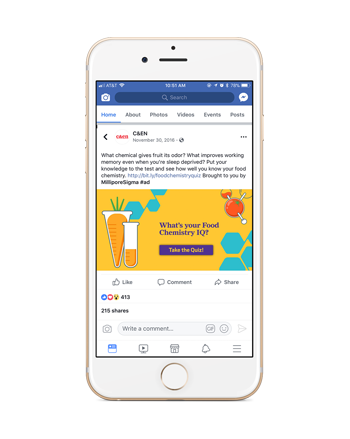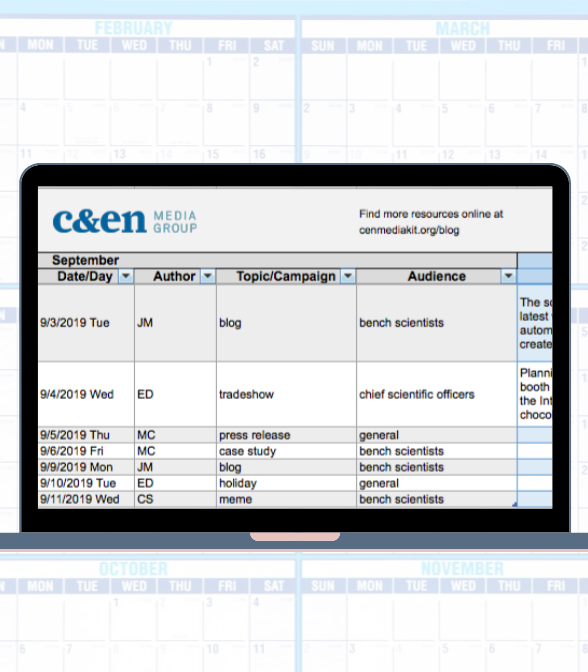With increased adoption across a diverse range of demographics, social media is a technology that won’t be going away, making it even more critical to incorporate into your marketing toolkit.
Over 73% of marketers state that social media has been an effective tactic, according to Buffer, and a Nature Jobs survey confirmed that roughly 40% of scientists and engineers use LinkedIn and Facebook. Add the over 3.5 billion social media users worldwide, and it becomes a challenge to figure out how to manage it all.
Keep reading to learn methods to keep your existing social channels thriving, including how to keep followers engaged and how to approach paid promotions.
Common challenges with social media, and how to overcome them
It can be argued that science industries are still in the early stages of social media maturity. On the one hand, this brings an array of concerns about how to participate effectively and efficiently. On the other hand, it presents a great opportunity for companies to pave the way and earn a strong share of voice.
Here are some common obstacles to corporate social media adoption in the sciences and ways to overcome them:
1. Lack of planning
At first glance, keeping up social accounts might seem like it can be a back-of-mind task, and all too often, that’s exactly how they get started. Just share your thoughts when they occur, right? Not quite.
It’s easy to let social media get buried under other urgent tasks, so try managing your socials like you manage your supply lines. Create long term goals for growth you’d like to see: followers, leads, and interactions. Select content suppliers: writers within your company or external news sources. Secure a plan for execution – who will post? How frequently?
Once you have this all down in writing, it’s easy to bring additional help on board to take your social to the next level, because your goals and values are all defined and recorded.
2. Difficulty defining ROI
Social media is not always a tit for tat game. Having active social accounts leads to brand awareness, which can then be developed into lead generation, but that connection isn’t immediately visible. However, there are still a few key performance indicators that can help define the success of social media marketing efforts. Some easy ways to benchmark your performance include:
- Measuring the reach of your content through your follower count and the impression/engagement numbers for your posts. Depending on the platform, engagements should largely be prioritized over follower counts, however, so pay attention to whether you’re growing your engagement rates along with your followers.
- Evaluating the content itself against engagement numbers to define what messaging and tactics are most effective. Visuals play very well in the chemical sciences and we’re lucky to have a lot of great options. Just browse through the #SciArt or #FluorescenceFriday topics on Twitter for inspiration.
3. Regulatory compliance issues
As we all know, the sciences are a heavily regulated industry. Making sure your company and its social media content are within those standards can be a headache if you try to do it on your own.
Luckily, there’s plenty of social media compliance guides out there that help clearly define regulations and lay out how to stay within good practices. If you’re spending too much time analyzing each and every post, it may be because your content is too self-promotional. It’s much easier if you also share third-party content, such as great industry articles, or fun seasonal posts when holidays roll around.
Next-Level Tips and Best Practices
The first step in any social program is always establishing a respectful and relevant corporate account, with a history of quality content and audience engagement. Once in place, it’s time to take it to the next level with the following tactics.
1. Get your employees involved
There are so many advantages to having your employees engage with and amplify your company’s social media. For starters, they often have relevant networks that will dramatically expand your reach – think colleagues from previous companies, industry peers, clients, vendors; even the folks they did their PhD with. Their participation increases the number of impressions your posts will receive while giving your account an added boost of credibility and connection.
According to the employee advocacy platform EveryoneSocial, employees have 5x more reach than corporate accounts and people that follow your employees on social media are 7x more likely to convert. It’s the perfect way to capitalize on your foundational social media work.
In practice, employees need training and guidelines to operate effectively (as with medicine, “first do no harm”). To get started on a company strategy in this area, take a look at some of the many available resources and guides.
2. Create multimedia attention-grabbers
If you’re on social platforms, you’re likely already posting about a variety of relevant topics and using eye-catching photos to increase engagement. But are you also using video effectively?
Research has indicated that video content is now the #1 form of media used in social content strategy, surpassing even infographics and blogs. Furthermore, this same report indicates that the posts that garner the most engagement include photos and videos.
Of course, when in doubt, the internet is always a welcoming place for pet photos – check out this cute example from Bio-Rad.
3. Check in and evaluate your campaigns
Social media can be a place where companies get to show their “human” side by sharing their thoughts and values. However, if you choose to automate by scheduling what content you think your audience needs, then make sure to check in on its performance too. It can be easy to forget about this element when you get into a posting groove.
See which topics are getting interactions and put more of them out there. A lot of social management platforms have robust analytics built in, like Falcon or Sprout Social. You can go a step further by using tools like SparkToro to identify your audience’s favorite accounts, news sources, and hashtags.
For science content, this doesn’t just mean posting about how cool your new technology is, it also means joining conversations like #PhDChat or #AcademicChatter.
4. Get interactive
There are a lot of ways to ask your followers to engage directly. Essentially all social media channels have integrated features that allow for polling and Q&As. Now that you’ve established your social channels, these can be a great tool to create dialogue with (and amongst) your followers, as well as to get insights and opinions that can feed back into your social strategy.
You can also leverage social media as a way to host contests and share some giveaways that spotlight your customers. As an example, Cemex Global recently did a call for submissions via Twitter for a photography competition this year.
C&EN also works with advertisers on sponsored social campaigns, like Merck Millipore’s Polar Bear “giveaway” or KNF’s pun contest.

Click here to sign up for our Marketing Elements blog and receive a free social media case study for running contests through a publisher.
Working with a publisher with their own established following is a great way to bring a new set of eyes to your efforts – which leads us to our next suggestion.
A Powerful Paid Boost
Just like other media platforms, there is always an avenue to use advertising dollars to bring increased visibility and awareness to your social media content. But social advertising allows you to think outside of the box of traditional advertising as well. Tools will vary by platform: for instance, LinkedIn allows for simple text-based ads as well as sponsored messages sent through their messaging system, called InMail.

All social advertising tools let you carefully select the groups of people who will see your promoted posts. The first step is identifying the groups you want to target. Think about who will be most likely to engage with your content and products – based on factors such as age, interests, location, and organizational affiliations – and personalize your content with those people and businesses in mind. Remember the stat from earlier about how people who follow your employees on social media are 7x more likely to convert? If your brand is on Facebook, you can specifically target friends of the people who already follow you there.
Note that Facebook’s Ad Manager is more robust than the simple “boost post” option, so make sure to take advantage of the advanced features. On LinkedIn, paid advertising is more expensive, but it can be worth the investment to target specific contacts in the B2B space. To make the best use of your budget, think about using LinkedIn for lead generation campaigns so you can continue to nurture the contacts you gain there beyond the platform.
Many social media platforms have integrated tools to monitor and optimize the performance of paid posts as they run, so you can narrow your scope even further to hit that audience “sweet spot.” Using these performance monitoring tools, you can conduct A/B testing to compare wording and content pieces and determine what performs best with your target audience. As a result, you can be refining your strategy while you’re implementing it, constantly improving as you go.
Consider how all your campaigns fit together
Social advertising isn’t a standalone endeavor. Consider a three-pronged approach across channels to get the most value from your spend. Use email marketing campaigns to raise awareness with your existing lists, and social media advertising to reach new audiences. Once those campaigns have ended, use a retargeting ad platform to run complementary ads to help push conversions and sales. If your social advertising audience didn’t convert, perhaps your prospects need to learn more about your company or your customer service capabilities. Essentially, think of the types of ads you can serve to a group who already expressed intent.
Now What?
Now that you’re equipped with strategies to bring your social profiles to the next level, you can venture forth on your journey to really create effective content and find a way for your brand’s voice to be heard. Luckily, we live in an age where resources, tools, and data are available at our fingertips. When used properly, and supported with proper training, it is possible to leverage social media as a very powerful storytelling tool.



















